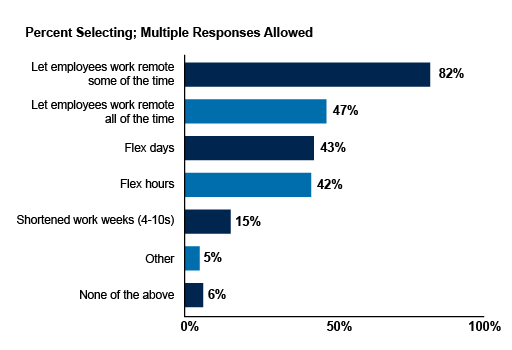1 The new normal
The COVID-19 pandemic has been a catalyst to experimenting with flexible ways of working, and we are still on a journey to understand what hybrid means and to (re)design optimum ways of working in a world where 9–5 in an office is no longer assumed to be the norm.
According to Sage (2022) ‘hybrid working is the new normal’ and the pandemic is responsible for accelerating the ‘greatest global shift in work for a century’ (Gratton, 2022). There are many changes occurring in business and lots of transformations taking place, for example automation is reshaping industries such as auditing, as seen at Deloitte, and this changes the roles those industries require. We are now living longer than ever and retiring later, and issues of equity, diversity and inclusion are more prominent than ever. It is fair to say that what our parents’ generation needed and wanted from work is not what we want from work now, and businesses are having to respond rapidly to this.
According to Gartner [Tip: hold Ctrl and click a link to open it in a new tab. (Hide tip)] (and as seen in Figure 1 below), 82% of company leaders plan to continue to offer remote working after the pandemic.
Meanwhile a report published by Cisco/ Webex in 2021 said that ‘the hybrid worker era is here’ (Dimensional Research, 2021) and that 68% of those surveyed were already working from both home and the office. What is not surprising is the amount of people who said that they would actually leave an organisation if there was no option for hybrid working.
That being said, the report did identify that people are concerned with digital tooling and teaming, that the need to be able to collaborate effectively was still key, and that there is a need for advanced collaboration solutions.
We are at a significant point – do we return to the older ways of working, or do we take this opportunity to transform and redesign our working environment? This course will guide you through a toolkit of possibilities, but it does not claim to offer a ‘one size fits all’ solution. Whatever path you take, as a leader you will require self-knowledge, the ability to build empathy and understanding with your teams and also to develop their digital capabilities. You will need to design, test, iterate and keep creating new ways of working that suit your context and your stakeholders.
This course is designed to encourage you to consider who you are as a leader working with hybrid teams, and how you work with those teams. You will have opportunities throughout the course to carry out reflections and develop action plans to enable you to strengthen your skills as a hybrid leader.
Activity 1 Hybrid working in 2022
Watch this video What hybrid working will look like in 2022 and reflect on any thoughts or concerns you might have as a leader around hybrid working with your team(s).
How do the preferences of women and people from Black and Minority Ethnic backgrounds stated in the video fit with the diversity of your organisation?
How does redesigning ways of working to include hybrid options really make you feel – are you aware of being biased one way or another?
You will get the chance to revisit these initial reflections at a later point in the course, to see if your views have changed.
If you want to, add your notes to the text box below.
Discussion
This video was originally posted in December 2021. How accurate have its predictions proved to be in your organisation – or to your sector more widely?

